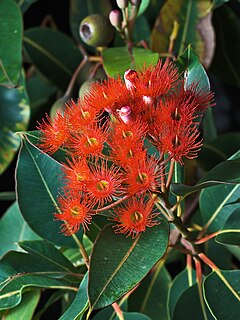
Corymbia ficifolia (syn. Eucalyptus ficifolia, commonly known as the red flowering gum, is a species of small tree that is endemic to the south-west of Western Australia. It has rough, fibrous bark on the trunk and branches, egg-shaped to broadly lance-shape adult leaves, flower buds in groups of seven, bright red, pink or orange flowers and urn-shaped fruit. It has a restricted distribution in the wild but is one of the most commonly planted ornamental eucalypts.

Eucalyptus microcorys, commonly known as tallowwood, is a species of medium to tall tree that is endemic to eastern Australia. It has rough, fibrous or string bark on the trunk and branches, lance-shaped to egg-shaped adult leaves, flower buds in groups of seven or nine, white to lemon-yellow flowers and conical fruit. It grows in forests near the coast of Queensland and New South Wales.
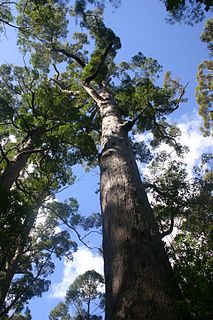
Eucalyptus jacksonii, commonly known as the red tingle, is a species of tall tree endemic to the south west Western Australia and is one of the tallest trees found in the state. It has thick, rough, stringy reddish bark from the base of the trunk to the thinnest branches, egg-shaped to lance-shaped adult leaves, flower buds in groups of seven, white flowers and shortened spherical to barrel-shaped fruit.

Eucalyptus quadrangulata, commonly known as the white-topped box or coast white box, is a species of small to medium-sized tree that is endemic to eastern Australia. It has rough, fibrous or flaky bark on the trunk and branches, lance-shaped to curved adult leaves, flower buds in groups of seven, white flowers and conical fruit.

Eucalyptus pellita, commonly known as the large-fruited red mahogany, is a species of medium to tall tree that is endemic to north-eastern Queensland. It has rough, fibrous or flaky bark on the trunk and branches, lance-shaped to egg-shaped adult leaves, flower buds in groups of seven, white flowers and cup-shaped to conical fruit.

Eucalyptus magnificata, commonly known as blue box or northern blue box, is a species of small tree or sometimes a mallee that is restricted to a small area of New South Wales. It has rough, fibrous or flaky bark on the trunk and larger branches, smooth bark above, broadly lance-shaped to egg-shaped leaves, flower buds in groups of seven, white or pale yellow flowers and conical fruit.
Eucalyptus calyerup is a tree that is endemic to a small area in the south-west of Western Australia. It has rough, fibrous bark on the lower part of the trunk, smooth bark above, elliptic to lance-shaped adult leaves, flower buds in groups of seven, creamy-yellow flowers and conical to bell-shaped fruit.

Eucalyptus brevistylis, commonly known as Rate's tingle, is a tree that is endemic to the south-west of Western Australia. It has fissured, fibrous to stringy bark, lance-shaped adult leaves, flower buds in groups of between nine and thirteen, white flowers and almost spherical fruit with a small opening.
Eucalyptus laevis is a species of mallee or tree that is endemic to Western Australia. It has thin, rough, fibrous or flaky bark on the trunk, smooth bark above. Its adult leaves are linear to narrow lance-shaped, the flower buds are arranged in groups of between seven and eleven, the flowers are white and the fruit is cylindrical to barrel-shaped.
Eucalyptus limitaris is a species of tree or mallee that is endemic to north-west Australia. It has rough, flaky or fibrous bark on the trunk and branches, lance-shaped to curved adult leaves, flower buds in groups of seven on a branching peduncle and conical to barrel-shaped or cup-shaped fruit.

Eucalyptus longicornis, commonly known as red morrel, morryl, poot or pu, is a species of large tree that is endemic to the south-west of Western Australia. It has rough, fibrous, fissured bark on the trunk, smooth greyish bark above, flower buds in groups of seven or more, white flowers and shortened spherical fruit.

Corymbia nesophila, commonly known as the Melville Island bloodwood, is a species of tree that is endemic to northern Australia. It has rough, tessellated bark on the trunk and branches, lance-shaped or curved adult leaves, flower buds in groups of seven, creamy white flowers and urn-shaped fruit.
Eucalyptus remota, commonly known as the Kangaroo Island ash, Kangaroo Island mallee ash, or Mount Taylor mallee, is a species of tree or mallee that is endemic to Kangaroo Island in South Australia. It has smooth bark, often with rough, fibrous bark on the trunk, lance-shaped adult leaves, flower buds in group of between nine and twenty one, white flowers and hemispherical or shortened spherical fruit.
Eucalyptus gigantangion, commonly known as Kakadu woollybutt, is a species of tree that is endemic to the Northern Territory. It has soft, fibrous bark most of the trunk, smooth white bark above, narrow lance-shaped adult leaves, flower buds in groups of seven, orange-coloured flowers and ribbed, urn-shaped fruit.
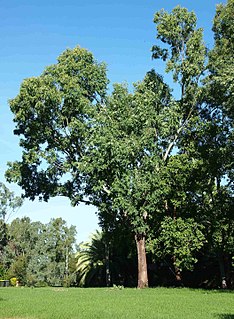
Eucalyptus raveretiana, commonly known as the black ironbox, is a species of small to medium-sized tree that is endemic to Queensland. It has rough, fibrous or flaky bark on the trunk and larger branches, smooth pale grey bark above, lance-shaped leaves, flower buds in groups of seven on a branched peduncle, white flowers and small, hemispherical fruit.
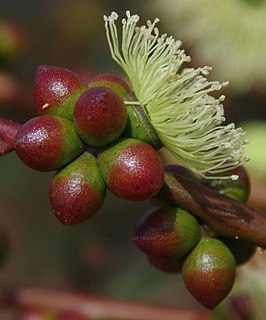
Eucalyptus terebra, commonly known as Balladonia gimlet, is a species of gimlet that is endemic to Western Australia. It has satiny or glossy bark on its fluted trunk, linear to narrow lance-shaped adult leaves, flower buds in groups of seven, yellowish flowers and conical to hemispherical fruit. It is one of the seven species of gimlet.
Eucalyptus hypolaena is a species of tree or mallee that is endemic to Western Australia. It has hard, dark grey bark near the base of the trunk, smooth bark above, lance-shaped adult leaves, flower buds arranged in groups of seven, pale yellow flowers and shortened spherical to barrel-shaped fruit.
Eucalyptus infracorticata is a species of mallee that is endemic to a small area of Western Australia. It has rough, flaky or fibrous bark on the lower part of the trunk, broad lance-shaped adult leaves, flower buds in groups of between seven and eleven and short cylindrical fruit.
Eucalyptus longissima is a species of mallee or small tree that is endemic to the south-west of Western Australia. It has rough, fibrous or stringy bark on the trunk, smooth greyish brown bark above, glossy green, lance-shaped adult leaves, flower buds in group of between seven and thirteen, white flowers and shortened spherical fruit.
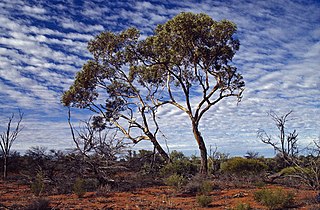
Eucalyptus socialis subsp. victoriensis, commonly known as the red mallee, is a subspecies of mallee that is endemic to southern inland Australia. It usually has rough bark on the base of the trunk, smooth bark above, lance-shaped adult leaves, flower buds in groups of between seven and eleven, pale creamy yellow flowers and barrel-shaped to urn-shaped or spherical fruit.















